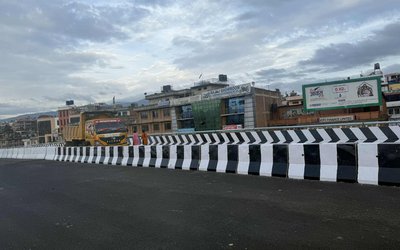More on News






Governments of India and Nepal were completely taken by surprise when year before last the eastern embankment was suddenly breached and the Kosi shifted its course to the east. Despite that horrifying flood disaster experience both the governments are not as yet seen taking much interest to find satisfactory ways to protect the life and property of millions from the oncoming Kosi floods feared to strike again anytime soon . The year before last’s flood disaster is indeed the forewarning of a far greater catastrophe.
Hanging River
Kosi river held back between the embankments since the last half a century and now flowing well above the adjoining lands has already turned into the world’s deadliest river. World might be heading for the rerun of the worst flood disasters reminiscent of the past Yellow river disasters when each time the flood took the life of a record number of people. Already the peoples of Nepal and India are in grave danger. Unfortunately the governments of both countries are seen even until now unable to get to the root of the Kosi flood problems. Indian Government was even telling just few years back that the Kosi flood control problem does not exist. During the run up to the 1997 Indo-Nepal joint committee meeting on Kosi several letters were received from the Govt. of India explaining our government that the Kosi flood control problems have already been solved once for ever after the completion of the construction of the embankments
Analogy with Yellow River
The Yellow River of China known as “the Sorrow of China” resembles to a considerable extent the Kosi River similarly known as “the Sorrow of Bihar”. The killer Yellow River has already been tamed after the completion of the construction of several storage dams and it has completely relinquished its aggressive character, whereas the greatly feared Kosi River held back by side embankments and now flowing well above the adjoining surrounding lands remains a great danger to life and property of millions of our region.
Judging from the angle of similarity between these two rivers the way they roamed rampaging their vast floodplain quite often completely changing their course, it appears, the world might be very close to the deadliest catastrophe triggered by the failure of the Kosi embankments. Now the safety of the peoples living in the Kosi floodplain must be at the top in priority.
World’s Worst Natural Disasters
Among the world’s top five worst natural disasters are the 1931 Yellow River flood in China, the 1887 Yellow River flood, the 1938 Yellow River flood, the Bhola Cyclone of 1970 in East Pakistan (now Bangladesh) and the 1556 Shaanxi earthquake in China. The next five in order of severity are the 1839 Cyclone in Coringa India, the 1642 Kaifeng flood in Henan province China, the 2004 Indian Ocean Earthquake and Tsunami in various nations, and the 1138 Allepo Earthquake in Syria.
The 1931 Yellow River flood devastated the China in summer. It took the lives of people numbering between one to four millions. It is the worst natural disaster ever to have been recorded of any time. The 1887 Yellow River flood resulted from a long period of rains which caused the river water to rise above the man made dikes. When that happened, it resulted in the worst natural disaster ever recorded prior to the 1931 flood. It is believed that between 900,000-2,000,000 people had lost their lives in that horrible disaster. The 1938 Yellow River flood disaster claimed the lives of people numbering between 500,000 and 900,000.
Existing Kosi Project
The Kosi embankment and barrage had been designed for a maximum flood discharge of only 9.5 lakh cusecs. Within the last 50 years twice the flood discharge close to 9 lakh cusecs have been recorded. Surprisingly, the maximum flood discharge recorded within the last 40 years was only around 5 lakh cusecs. As a result, it was not necessary to face up to the problems of the breach in embankment.
The annual rate of the sedimentation upstream barrage based on the observations as of the early 1980s is about 5 cm per annum. It implies that within the last 50 years after the commissioning of the barrage a layer of 2.5 meters thick sediments might have already deposited on the river bed. At present the capacity of the embankments to safely hold back the maximum flood might have been reduced to the extent as low as only about 5 lakh cusecs, and even such greatly diminished capacity is decreasing further year by year due to continued bed level rises.
A New Cycle of Disasters
It is pretty obvious that in future the breaching of the Kosi embankments even during minor floods would be a regular phenomenon and on such occasions there would be a rerun of the year before last’s flood disaster episode. If there would be a breach in embankment at the time of maximum flood discharge close on nine lakh cusecs., a discharge already recorded twice within the last fifty years, there could be a total devastation of the north-east Bihar. Most of the low lying areas would be quickly submerged way deep inside the water particularly if the breach coincides with prolonged incessant rain. Too many people would not have time to reach the safety of the high grounds. No wonder in similar circumstances the loss of life in China used to be in astronomical number!
Physical Process
When the Kosi bursts the embankment at extremely high river discharge several very adverse hydraulic factors would be brought into play. All of them are compounded to result in the most dreadful flood disaster. In this process the relegated old Kosi channels would be reactivated one after another.
If there is a breach in embankment, say at a flood discharge of 9 lakh cusecs, perhaps the initial flow channeled through the newly reactivated Kosi old channel could even reach 18 lakh cusecs, which would be the combination of the base flood discharge and the flow from the negative surge moving upstream. These hydraulic phenomena would result in very rapid current of the positive surge heading downstream all along the fully reactivated old channel expected at that time to be full of water drained from the local catchment.
Sediments Play Havoc
Sediments previously heaped up on the river bed of the Kosi would be quickly flushed down to the reactivated channel by the fast running flood water gushing out from the original course. Soon the upper reach of the newly reactivated channel would be throttled with sediments. Thereafter the bulk of the flood water would be concentrated on the next adjacent reactivated channel. This channel too would be choked with sediments. This process of reactivating the old channels would be repeated again and again until the Kosi flood water reaches the far end of its floodplain unless the flood quickly subsides. Thus the sediments would be playing havoc. Prevention of the breach in embankment must be at the top in priority.
Buffer Channel
At present the capacity of the present Kosi river channel to hold back big floods is greatly reduced. It would not anymore be possible to confine always the river within the boundaries of the embankments to prevent the rerun of the last disaster. However, the loss of life and property can be greatly reduced by preventing the Kosi to roam freely to rampage its vast floodplain. For this purpose one of the relegated old Kosi channels must be developed as a buffer channel for the diversion of the high flood water in excess of the carrying capacity of the present Kosi course. A spillway must be provided to discharge safely the flood water across the embankment into the buffer channel, which could also help to hold back the sediments already accumulated on the river bed.
Postponement of Kosi Dam Project
It would be a big mistake to opt to implement at the very beginning the mammoth Kosi dam project to resolve the rapidly worsening flood situation. It will take a very long time to complete the detailed study and construction of the optimum sized Kosi dam project, that might have a dam perhaps the highest in the world and a hydropower plant capable to generate about 16,000 MW in accordance with further studies based on more correct recent data and well tested evaluation procedures recently applied in the Karnali project study
Recommended Method of Kosi Flood Control
The implementation of relatively small Sun-Kosi Project and the Tamar-1 Project provided with adequate flood control storage would suffice to resolve the present Kosi flood problems at least for a period of next 50 to 60 years. There could be a possibility to incorporate to a limited extent the provision for the Arun river flood storage also by raising the present dam height of the Arun-3 project.
The useful life of the above proposed reservoirs could be prolonged to last for ever by applying the technology widely used in China to vent sediments as a density current. Further aggradations of the Kosi river bed could also be prevented if it is found commercially feasible to transport in big barges the sediments drawn from the Kosi river near Chatra for use in construction by using the proposed Kosi canal waterway.






